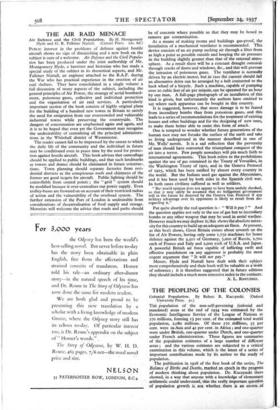THE AIR RAID MENACE
Air Defence and the Civil Population. By H. Montgomery Hyde and G. R. Falkiner Nuttall. (Cresset Press. I2S. 6d.) PUBLIC interest in the problems of defence against hostile aircraft shows no sign of diminishing and a new book on the subject is sure of a welcome. Air Defence and the Civil Popula- tion has been produced under the joint authoiship of Mr. Montgomery Hyde, a barrister and historian who has made a special study of the subject in its theoretical aspects, and Mr. Falkiner Nuttall, an engineer attached to the R.A.F. during the War who has practical experience in the erection of air raid shelters. They have consolidated in a single volume a full discussion of many aspects of the subject, including the general principles of Air Power, the strategy of aerial bombard- ment, poisonous gases, collective and individual protection and the organisation of air raid services. A particularly important section of the book consists of highly original plans for the building of a hundred new towns in Britain to satisfy the need for emigration from our overcrowded and vulnerable industrial towns while preserving the countryside. The dangers of concentration are emphasised again and again, and it is to be hoped that even yet the Government may recognise the undesirability of centralising all the principal administra- tions in the Whitehall district of Westminster.
The reader cannot fail to be impressed by the extent to which the daily life of the community and the individual in future may be conditioned even in peace time by the need for protec- tion against hostile aircraft. This book advises that camouflage should be applied to public buildings, and that such landmarks as towers and domes should be eliminated in future construc-, tions. Town planning should separate factories from resi- dential districts as the conspicuous roofs and chimneys of the former are good targets for aircraft. Public lighting shoUld be controllable from central points ; the " grid " system should be modified because it over-centralises our power supply. Even trolley-buses are frowned on on account of their restricted radius of action and the vulnerability of the overhead system. The further extension of the Port of London is undesirable from considerations of decentralisation of food supply and storage. Motorists will welcome the advice that roads and paths should be of concrete where possible so that they may be hosed to remove gas contamination.
As a means of making rooms and buildings gas-proof, the installation of a mechanical ventilator is recommended. This device consists of an air pump sucking air through a filter from as high a point as possible outside and keeping the air pressure
in the building slightly greater than that of the external atmo- sphere. As a result there will be a constant draught outwards through cracks of doors and windows, &c., and this will prevent
the intrusion of poisonous gases. The ventilator is normally driven by an electric motor, but hi case the current should fail an alternative drive can be arranged by a belt connected to the
back wheel of a bicycle. Such a machine,, capable of pumping over 20 cubic feet of air per minute, can be operated for an hour
by one man. A full-page photograph of an installation of this kind is given, but unfortunately the authors have omitted to say where such apparatus can be bought in this country.
It is suggested, however, that more damage is to be feared from incendiary bcimbs than from poisonous gases, and this leads to a series of recommendations for the treatment of existing houses and other buildings and for the designing of new ones, to make them better able to resist this form of attack.
One is tempted to wonder whether future generations of the human race may not forsake the surface of the earth and take to living underground in the manner described in one of Mr. Wells' novels. It is a sad reflection that the perversity of man should have converted the triumphant conquest of the air into a terror. Few people nowadays will pin much faith to international agreements. This book refers to the prohibitions against the use of gas contained in the Treaty of Versailles, in the Washington Treaty of 5922, and in the Geneva Protocol of 5925, which has been ratified by almost every country in the world. But the Italians used gas against the Abyssinians, and it has been used by both sides in the Spanish civil war. In both cases civilians suffered as well as soldiers.
" But world opinion does not appear to have been unduly shocked, so that it may safely be assumed that no belligerent government will in the future be deterred by the Geneva Gas Protocol if any military advantage over its opponents is likely to result from dis- regarding it."
Put quite shortly the real question is : " Will it pay ? " And the question applies not only to the use of gas but to incendiary
bombs or any other weapon that may be used in aerial warfare. However much we may deplore it, this shows the absolute neces- sity for this country to build up an adequate air force. At present, as this bcok shows, Great Britain comes about seventh on the
list of Air Powers, having only _ ansome I,750 machines for home defence against the 3,500 of Germy, 5,000 of Russia, 2,700 each of France and Italy and 2,000 each of U.S.A. and Japan. A powerful British air force capable of inflicting swift and effective punishnient oh any aggressor is probably the most cogent argument that " It will not pay."
Messrs. Hyde and Nuttall have dealt with their subject most comprehensively and their book will be valuable as a wOrk of reference ; it is therefore suggested that in future editions they should include a much more extensive index to the contents.
A: L. RAWLINGS.


















































 Previous page
Previous page